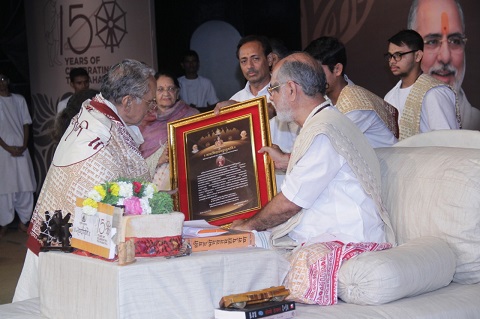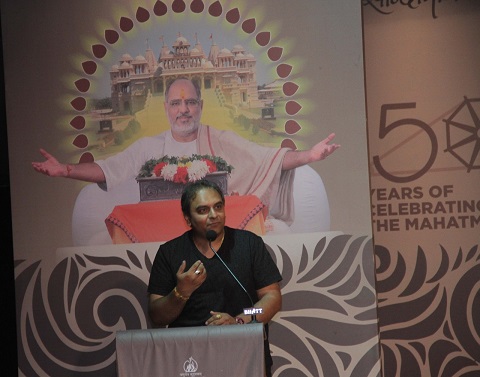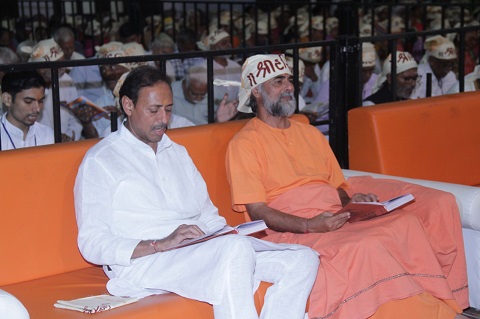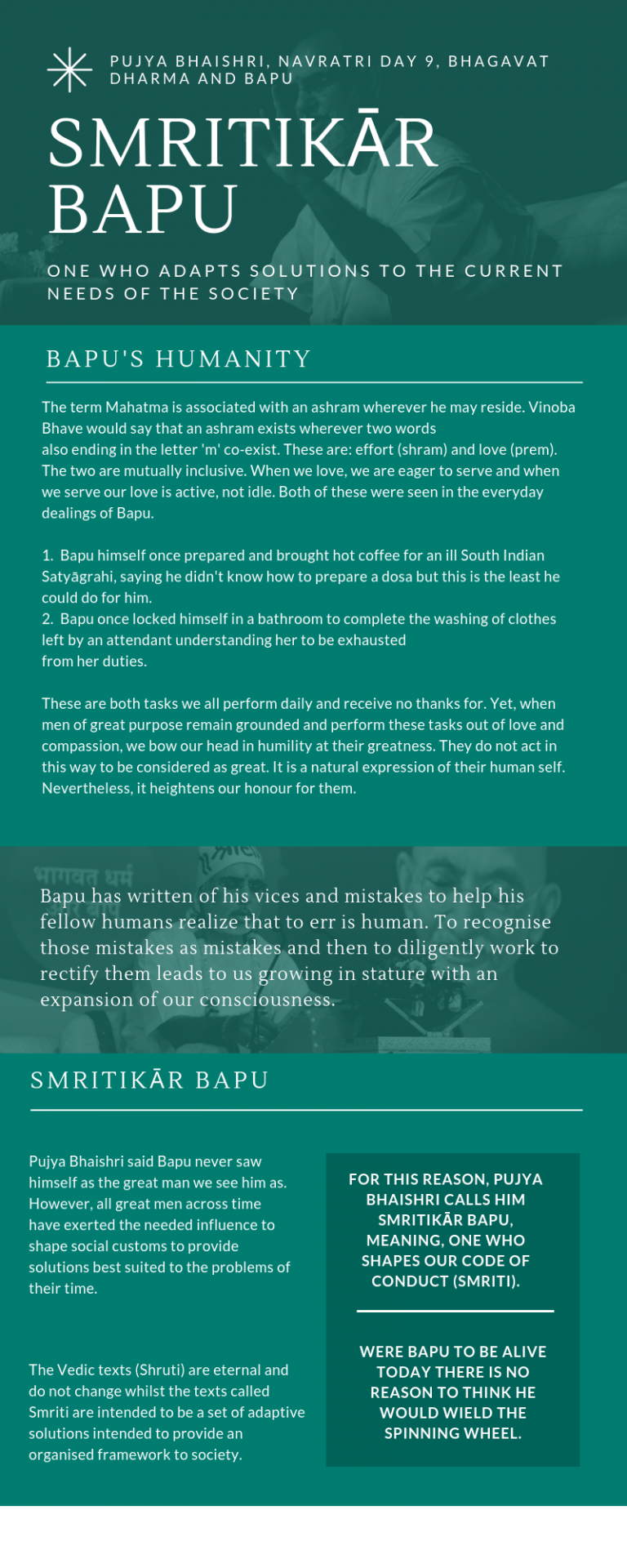On the final day of Navratri celebrations, after the musical recitation of Shri Ram Charit Manas, Pujya Bhaishri expressed his delight on the successful completion of the 38th Navratri Anushthan. He was also pleased to see the love the citizens of Porbandar and devotees from overseas have for Lord Ram’s name, the continuous singing of Lord Ram’s name by Shri Prembhikshuji Maharaj and the faithful remembering of Lord Ram and Hanumanji by Shri Vishwambhardasji Maharaj from Kutiyana. Pujya Bhaishri then bestowed his blessings to the chief host of the Navratri Anushthan, Shri Bajranglal Tapariaji.
Bapu, One who Adapts Solutions to Society’s Needs – Day 9 Navratri Celebrations


Speech by Shri Jay Vasavda
In the afternoon, we were joined by Shri Jay Vasavda, a Gujarati language writer, orator and columnist who discussed on the topic, Gandhi: Mahatma (great soul) and person. Shri Jay Vasavda said that one Mohan is Shri Krishna who remained detached despite living life fully as well having to renounce many things in life. Such was also Mahatma Gandhi who had to renounce plenty in order to become a Mahatma.
Those who criticise Gandhiji must not forget that just like we tolerate the mistakes made by our father in our house, similarly, we must disregard the mistakes made by Bapu. We must accept the mistakes made by Bapu in politics because Bapu learnt from the mistakes he made.
Pujya Bhaishri began the ninth and final day of deliberations regarding Bhagavat Dharma and Bapu with an overview of how and why that Supreme Being descends into the orbit of our human experience.
What is an avatar (incarnation) versus a vibhooti?
This process of ‘coming down’ and expressing one’s existence in simplified forms and actions that can be grasped by our senses and interacted with is called incarnation. Those that have directly realized this essence call that One by various names, primarily in these three categories:
- Vedantis call Him Brahma;
- Yogis call Him Paramātmā;
- Devotees call Him Bhagavān.
All that exists is the Lord as nothing exists except for Him. However, there are signature mediums in all moving and non-moving species of life (from trees, animals, planets to human beings and more) within which that Supreme Being exists and expresses himself in a special way, to a greater extent. These are called Vibhootis.


Is our Guru God?
Guru is a medium for direct realization. A disciple is able to realise the Supreme Truth for themselves to the extent that they have faith in the non-difference between their Guru and the Lord. However, the day the Guru considers himself to be God, he falls.
A true Guru never seeks to be at par with or ahead of the Lord and encourages his disciple to realize the Lord as Supreme and above all. This is why when a disciple seeks guidance as to whom to bow to, the Guru guides him to bow to Govind. It is this very humility that is the hallmark of a genuine Guru. He has no need to ‘become God’.
Ironically, the Lord is eager to simplify himself and bring himself down to the human level of experience whilst humans appear to be in a hurry to elevate themselves to the position of God!
The reality is that man is still an animal in the real sense of the word and not yet fully human, much less on our way to being God. Who is an animal (pashu)? One who is bound by the ties (pāsh) of delusion (moh). Lord Shiv is called Pashupati because He is the ruler of all animals.
Auspiciousness (Lord Shiv) lies in our evolution from brutes to human beings. May we learn to control our animalistic tendencies and fully express our most humane potential. This journey is made possible by Dharma (symbolised by the bull, the vehicle of Lord Shiv).
Top Gear of this human body vehicle
The goal is to see the One in all and that natural state is the highest state of existence. All other forms of devotion such as visiting holy places of pilgrimage, idol worship, prayer and meditation are likened to the first, second and third gear of a car. No vehicle can directly be put into its top gear. To realize, love and serve God in all is the top gear of this vehicle of our human body.

Bhagavat Sudama and Bapu
Pujya Bhaishri drew parallels between the two Mahabhagavat personalities of Porbandar: Sudama and Bapu. Both were in the householder stage of life and yet celibate in the true sense of the word (engaged in contemplation of Brahma, Brahmacharya); knowledgeable of the highest truth; exercised sensory restraint; devotees of the highest order (seeing God in all) and supremely peaceful by nature.

Idol worship – a preliminary necessity
Pujya Bhaishri read an excerpt from Bapu’s address to the Harijan community where he spoke of idol worship. He said that he understood that our restless mind needs and seeks a basis upon which to rest and place its faith in. Are not Islam’s insistence on the symbolism of its mosques or Christians swearing upon the Bible or Roman Catholics Mother Mary figurines all forms of idol worship in the wider definition of the term?
Pujya Bhaishri said that Bapu had no objection to any of these, he simply insisted that these were means to a greater end. They were never intended to be a means for earning revenue or commercialising Dharma.


